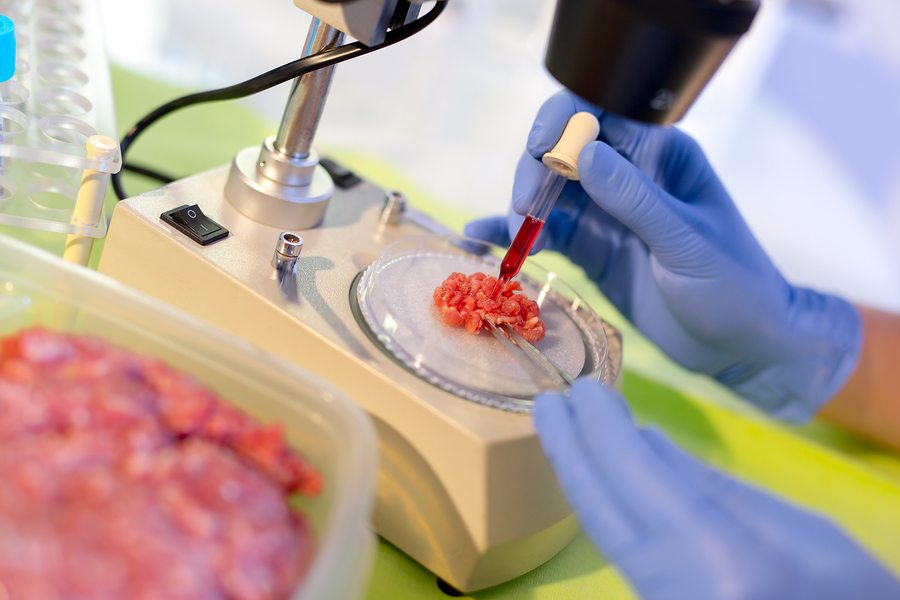A New Era of Protein? Lab-Grown Meat and Other Flexitarian Trends
February 6, 2018

Are you ready to eat a hamburger made of laboratory-grown meat?
The first such burger appeared in London in 2013. The developing market for lab-grown meat has only become more competitive since then.
Meanwhile, sophisticated mock-meat products have scrambled onto the market. More consumers are embracing the health and sustainability potentials of plant-based dining.
These trends present unique challenges to the food service industry around emerging tech and consumer preferences — even if no one’s quite ready to serve mass-market lab-grown meat just yet.
Bleeding Edge: Plant-Based Burgers
U.S. consumers still prefer meat, but plant-based proteins are a growing niche market that could hit $5 billion in the next three years. According to September 2017 data from market-research firm Nielsen, a majority of Americans regularly eat meat, but 39 percent are trying to eat more plant-based foods.
Hamburgers are classic staples and easy to package and cook, making them a no-brainer gateway for alternative proteins.
The Beyond Burger patty is primarily pea protein, layered with plant fats and imbued with beet juice to mimic a regular burger. The burger, which is already available in grocery stores, strategically sits right next to the regular meat patties in Whole Foods stores. Tyson invested in the company last year.
Its newest competition is the Impossible Burger, currently only available to restaurants. Producer Impossible Foods deconstructed the proteins in meat that create a satisfying burger experience and sought plant proteins that mirrored those effects, according to Wired.
The resulting patty is a mix of wheat and potato proteins for firmness and moisture retention, flavorless coconut oil for the fat, and plant-based protein to mimic the flavor of meat.
The company is hoping to dramatically increase production, but the Food and Drug Administration (FDA) raised concerns about a genetically modified organism (GMO) and whether it was allergen-free. Impossible Foods released a statement reasserting the product’s safety.
Both burgers offer a solution to a long-running issue with many vegetarians and vegans: flavor and the dining experience.
Leading Edge: “Clean Meat”
Lab-grown meat still has significant obstacles to overcome, including cost and controversy.
Scaling up operations from the bench to mass production requires:
- Large bioreactors, such as fermentation tanks, to grow more tissue cells
- Examination of environmentally sound and cost-effective options at every stage
- Better automation to keep production sterile and reduce the risk of contamination
How faux meat will be labeled and regulated by the FDA and/or Department of Agriculture (USDA) is yet to be determined. But the companies are communicating with agencies and trying to keep their practices within current standards.
Bill Gates, Richard Branson, agricultural giant Cargill and a handful of venture capitalists recently raised $17 million for the cellular agriculture company Memphis Meat, according to Forbes. The company is ahead of the pack as the first to produce lab-grown beef meatballs, chicken and duck — and plans to be market-ready in 2021.
Competitor Finless Foods claims it will have a blue-fin tuna replacement ready by the end of 2019, according to The Guardian.
Dr. Mark Post is the director of the “in vitro meat” program at Maastricht University in the Netherlands, which brought the “proof of concept” burger to London in 2013. He hopes to put a cultured meat product on the market in five years, under the label MosaMeat. His team is also working on methods to grow and add fat cells to the product.
Cost remains the most significant limitation for lab-grown meat. Cultured carp, provided by Finless Foods for its first tasting, cost around $19,000 per pound, while Post’s tiny concept burgers cost about $13,700.
Vegetarians, Flexitarians and Healthy Eating
Over the past 10 years, consumers under age 40 have increased their fresh vegetable intake by 52 percent, according to market research company The NPD Group. Gen Xers, millennials and Gen Zers are gravitating toward fresh vegetables and are likely to continue to do so.
For restaurants, vegetable-based dishes are generally lower-cost, and signature treatment can boost profit margins. Root-to-stem practices in the kitchen can reduce waste while using fruits and vegetables across the menu.
The key is to cook and build as much flavor as possible into the produce without bogging it down. Some restaurants are even removing the “Sides” section of their menus and replacing it with “Vegetables,” according to Restaurant Business. The dishes are still layered and built like sides, with condiments, cheese, pickles or finishing spice blends, but in a larger entree or shareable format.
Summary
While entrepreneurs rush to bring “clean meat” and new protein alternatives to market, the technology is still young, and its ultimate popularity and impact on the supply chain remains to be seen.
For operators looking for menu differentiation, opportunity remains in providing profitable veggie-based offerings.
Signature plant treatment and flavors may win over carnivores and the health-conscious alike, as it looks like everybody will be eating more of their vegetables in the years to come — if not yet a franken-burger.
- More food content: Restaurant trends for 2018
Recent Articles
Stay informed with Aprio.
Get industry news and leading insights delivered straight to your inbox.
